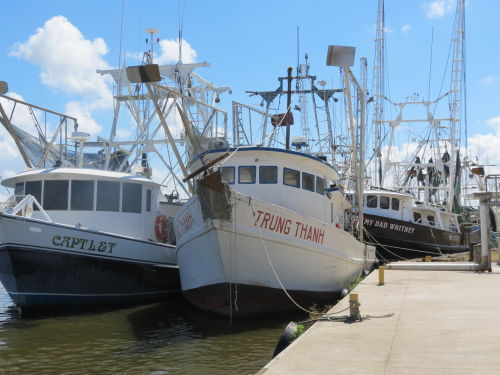
Shut down squeezes Laf. library out of headquarters
October 9, 2013TS Karen provides ‘drill’ for storm preparations
October 9, 2013All shrimp caught in Louisiana have been given a “red light” grade, an advisory that environmentally-conscious consumers not buy them, because of the state’s policy on sea turtle protection.
The Monterey Bay Aquarium’s Seafood Watch program, which rates seafood based on its sustainability and eco-friendliness, has placed all Louisiana shrimp among the 5 percent of US seafood products that it recommends its followers not purchase.
The Whole Foods supermarket chain is among outlets that make purchasing decisions based on the aquarium’s recommendations, which are readily obtained on the Internet or in a smart-phone application.
A Seafood Watch assessment of the U.S. shrimp fishery in the Gulf of Mexico and South Atlantic released Monday says that threats to sea turtles are among the nation’s most critical conservation issues, and that shrimp nets – which become non-threatening when turtle excluder devices are used – remain, at least in Louisiana.
U.S. fishery species assessed by Seafood Watch are rated either green – Best Choice – or yellow (Good Alternative). Those which do not qualify are rated red, for “Avoid.”
“Alone among Gulf of Mexico and South Atlantic states, Louisiana prohibits enforcement of federal requirements to use turtle excluder devices,” a report issued by the aquarium Monday states. “
The report concludes that most wild-caught U.S. shrimp remains a “Good Alternative” except for shrimp from Louisiana or shrimp caught in nets that haven’t been modified to protect sea turtles and other species caught accidentally by shrimp boats.
Under a 1987 state law, Louisiana officials are forbidden from enforcing TED requirements in state waters, where most shrimp fishing occurs.
“Even when conscientious Louisiana fishermen voluntarily comply with regulations that protect sea turtles, the state’s mandate not to enforce this essential measure creates a critical conservation concern and an ‘Avoid’ recommendation for all shrimp caught in Louisiana,” said Margaret Spring, vice president of conservation and science for the Monterey Bay Aquarium. Spring played a key role in crafting the Magnuson-Stevens Fishery Conservation Act, whose provisions are driving the recovery of fisheries in U.S. waters.
“In all other shrimping states – from the Carolinas to Texas – use of Turtle Excluder Devices has been effective in reducing impacts on sea turtles. We applaud the strong federal and state fisheries management policies that require TEDs, and the conscientious shrimp fishermen who are using TEDs. They are leading the way in sea turtle recovery.”
Seafood Watch uses scientific methods to assess both wild-caught and farmed seafood.
“If there’s a change in Louisiana’s management of its shrimp fishery to address the critical conservation concern around sea turtles, we can quickly revisit our recommendations to reflect that change,” said Seafood Watch Director Jennifer Dianto Kemmerly.
In addition to using TEDs to protect sea turtles, Kemmerly said that most U.S. shrimp boats use bycatch reduction devices that play a vital role in the recovery of commercially important fish species, like red snapper, that would otherwise be accidentally killed in shrimp trawling gear.
Bycatch reduction devices and TEDs are not required on the skimmer trawls used by some shrimp boats. Shrimp caught using skimmer trawls – a small fraction of total U.S. shrimp landings – also remains on the Seafood Watch “Avoid” list.
Fishermen and fish sellers said determining which type of gear was used to catch the shrimp can be a difficult task, however.
A proposed federal rule to require TEDs in skimmer trawls was withdrawn in February 2013.
Julie Falgout of Louisiana Seagrant said her agency has closely watched the battle that has continued in Louisiana for years over aspects of TED enforcement.
The agency she works for, however, is limited in what it can do.
“We do education and outreach to help fishermen comply with the existing laws,” Falgout said, noting that most Louisiana boats that travel federal waters have the devices. “If Louisiana does change it’s laws we will be training and teaching fishermen on the changes at that time.”
Seafood Watch regularly assesses wild-caught and farmed seafood based on peer-reviewed science reports published on the Monterey Bay Aquarium website. The reports incorporate input from fishing interests, academic experts, and federal and state fishery scientists and managers – including information from NOAA’s Fish Watch.
Seafood Watch reports and recommendations for all seafood items can be found online at www.seafoodwatch.org. The “About Seafood Watch” pages detail the assessment process and conservation criteria employed in developing seafood recommendations,
http://www.montereybayaquarium.org/cr/cr_seafoodwatch/sfw_aboutsfw.aspx.
Shrimp boats docked in Dulac Friday after offloading at Gulf Island Seafood. Concern for sea turtles has caused the Monterey Bay Aquarium to red-flag shrimp because Louisiana does not require enforcement of federal laws requiring turtle protection devices.








